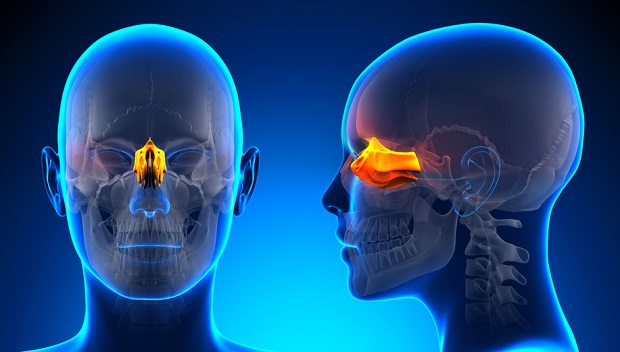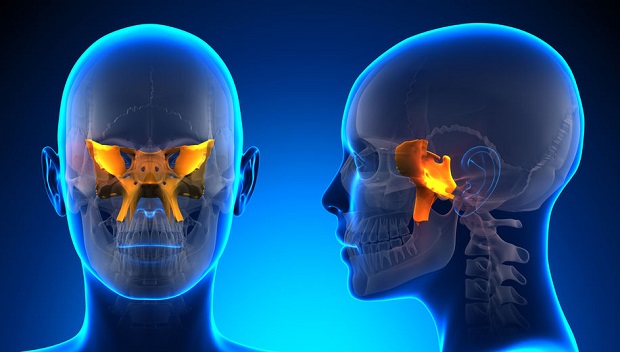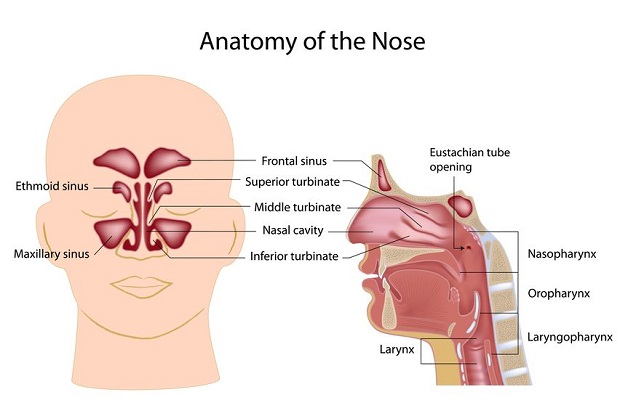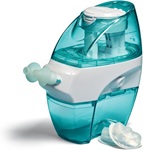
Can a Sinus Infection Cause Eye Problems?
Answer at a Glance: A sinus infection can cause several different eye issues.
Eye Problems Caused By Sinus Infections
- Ethmoid sinusitis is an infection of the ethmoid sinus behind the eye and can cause pain, pressure, or headache around the eyes.
- Sphenoid sinusitis is also located behind the eyes and can cause the same pain.
- An infection of the eye socket can result from ethmoid sinusitis.
- Another rare complication is orbital cellulitis, a skin infection around the eye.
Why Sinus Infection Symptoms Can Involve the Eyes
There are four sinuses—the maxillary, located behind the cheekbone; the frontal, located in the lower portion of the forehead; and the ethmoid and sphenoid, both located behind the eyes. [1] The symptoms of a sinus infection will parallel where they are located, which is why eye problems are generally a symptom of the ethmoid and sphenoid sinuses.
Ethmoid Sinusitis Can Cause Eye Pain

“©123RF.COM”
The ethmoid sinus is located between the nose and the eyes and is about the size of a walnut.
The ethmoid sinuses are located within the ethmoid bone in the nasal cavity. [2] Because all other sinuses drain through or adjacent to the ethmoid and maxillary sinuses, they are the most commonly infected. [3] Due to the location of the ethmoid sinus, several symptoms include eye pain, such as a headache around or behind the eye or pain and pressure in the corner of the eye where it meets the nose. [4]
Sphenoid Sinusitis Can Cause Vision Problems

“©123RF.COM”
Two large sphenoid sinuses are in the sphenoid bone, which is behind the nose between the eyes.
Like ethmoid sinusitis, the location of the sphenoid sinuses dictates its symptoms. The sphenoid sinuses sit just behind the posterior ethmoid sinuses, and an infection can cause pain, puffiness, swelling, and dark circles around the eye. The sphenoid sinus also sits just above the optic nerve. An infection of this sinus can compress the optic nerve, causing vision problems such as vision reduction or even loss of vision. [5]
What Is Orbital Cellulitis?
Orbital sinusitis is not common but can result as a complication of ethmoid sinusitis. [6] Orbital cellulitis is an acute infection of the eye’s tissues behind the orbital septum. The infection usually spreads through the blood or the sinuses adjacent to the eye. It may be caused by Haemophilus influenzae, Streptococcus pneumoniae, and Staphylococcus aureus. It is a dangerous infection that may cause blindness in children. Signs and symptoms include swollen eyelids, malaise, ocular pain, and difficulty moving the eye. Blood cultures and complete blood counts are used to test for an infection. Orbital cellulitis can progress quickly, and the patient must be monitored every few hours. Treatment includes antibiotics. [7]
Brain Infection Can Cause Visual Problems
Another serious complication of frontal and sphenoid sinusitis, though rare, is a brain infection. In this case, anaerobic bacteria spread from the sinuses to the brain, which can result in visual problems, headaches, mild personality changes, and altered consciousness. It can ultimately result in seizures, coma, and death. [8]
Glossary of Terms
Anaerobic bacteria: are bacteria that do not live or grow in the presence of oxygen.
University of Maryland Medical Center
Malaise: an indefinite feeling of debility or lack of health often indicative of or accompanying the onset of an illness.
Merriam-Webster Dictionary
Orbital septum: represents the anatomic boundary between the lid tissue and the orbital tissue.
Medscape
Expert Opinion
“Chronic sinusitis is also associated with glaucoma, and other problems in the eye, as chronic infection on all sides of the eye can lead to infections and problems in the eye.”
Dr Manik G Hiranandani Sinusitis and Ear Infections
References
- [1][4] eMedicinehealth.com – “Sinusitis Infection Symptoms.”
- [2] New York Eye and Ear Infirmary – “Ethmoidectomy & Antrostomy.”
- [3]The University of Wisconsin-Madison – “Sinusitis.”
- [5] Dr Manik G Hiranandani – “Sinusitis and Ear Infections.”
- [6] University of Michigan Medical Center – “Complications of Sinusitis.”
- [7] National Library of Medicine-National Institutes of Health – “Orbital Cellulitis.”
- [8] University of Michigan Medical Center – “Complications of Sinusitis.”
DISCLAIMER: THIS WEBSITE DOES NOT PROVIDE MEDICAL ADVICE
The information, including but not limited to text, graphics, images, and other material on this website, is for informational purposes only. No material on this site is intended to be a substitute for professional medical advice, diagnosis, or treatment. Always seek the advice of your physician or other qualified healthcare providers with any questions you may have regarding a medical condition or treatment before undertaking a new healthcare regimen, and never disregard professional medical advice or delay in seeking it because of something you have read on this or any other website.








